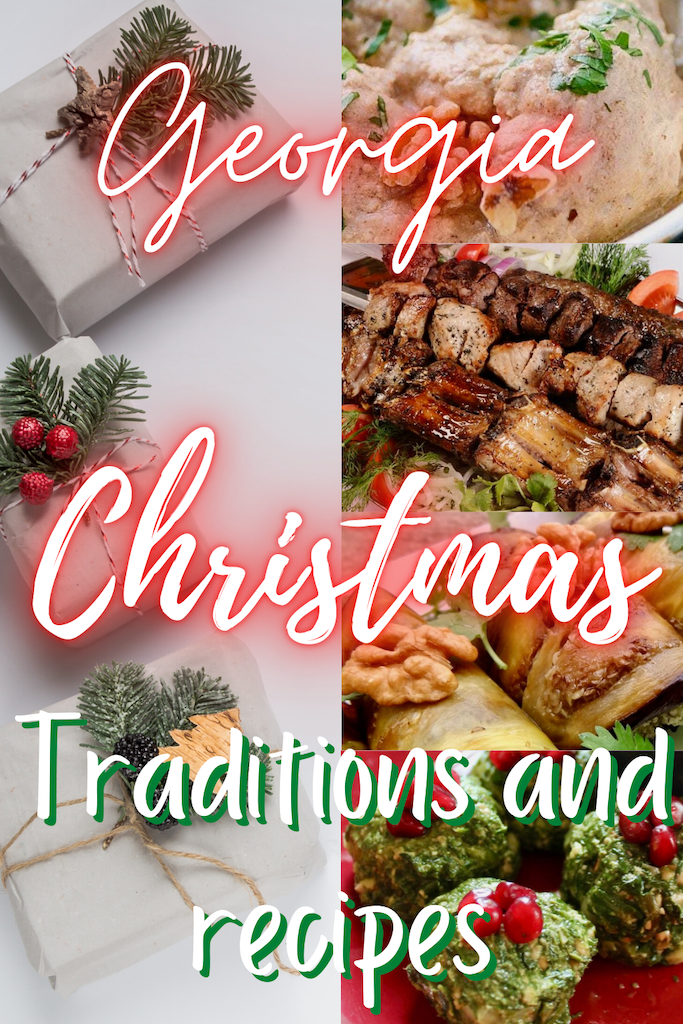

December 25, Christmas is one of the most significant dates in the Christian calendar. It is known as the birth of Jesus of Nazareth at the time of the winter solstice. But for some, it is a popular celebration disconnected from its religious foundation.
Indeed, Santa Claus and his gifts, the Christmas tree, decorations, songs, and family meals can trump nativity. When asked about my Christmas memories, I’m transported back to my childhood and the magic of Santa Claus. It all starts when we receive the toy catalogs and we have to send him our heartfelt letters. What stress, but also what memorable moments!
Christmas is always a magical time for me. Whenever I visit a new country in the run-up to Christmas, I get the itch to learn about its customs.
At the time of writing, I’m in Tbilisi, Georgia in the Caucasus region.
The country has been welcoming and very open. In Georgian culture, visitors are sent by God and must be received with warmth.
I assure you, they smother guests with affection but in a good way.
Moreover, a huge statue overlooking the old town, the “Mother of Georgians,” symbolizes this trait of national character: in her left hand, she holds a bowl of wine to greet those who come as a friend, and in her right hand a sword for those who come as an enemy.
It is also a country where a good meal served with good wine is the key to a harmonious life. And I confess that the first time we went to a restaurant, we feasted on excellent Georgian dishes and their wines.
I can only imagine how their festive meals go!
But before we talk about The Christmas meal, the traditions of the country
Georgians celebrate Christmas on January 7 of our civil calendar.
Why?
It is because Georgians are Orthodox, and the Georgian Orthodox Church is one of the four Orthodox churches that still follow the Julian calendar. The others use the revised Julian calendar, the one in which 13 days have been removed to align with the Gregorian calendar — the calendar of Catholic churches and our civil one.
For the curious, the explanation of the 13-day lag
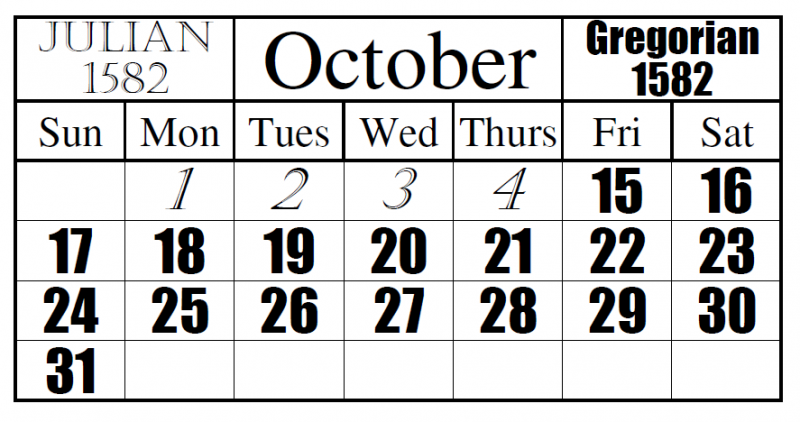

The Gregorian calendar was adopted the day after October 4, 1582. It was decided that year, the day after October 4 would not be October 5, but the 15th. That’s a 10-day difference. I couldn’t find a clear explanation for it! If we add the different ways of defining leap years, we come up with a difference of 13 days.
So as civil January 1 arrives before Julian December 25, chronologically, the new year is celebrated before Christmas in Georgia.
The new year celebrations
It all begins on December 31, the day of Tovlis Babua, the Georgian Santa Claus.
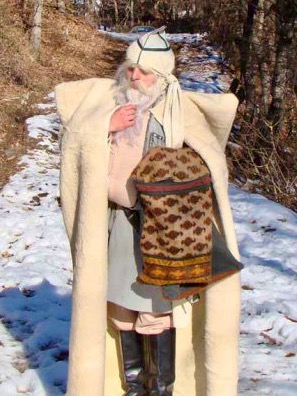

Georgian children also have their Santa Claus, Tovlis Babua, the “snow grandfather.” He is dressed in white traditional Georgian clothing and a white fur coat called “nabadi.” This coat, made of sheep’s wool, is heavy and very warm. The same style of coat was worn by shepherds but in darker colors.
On the eve of New Year’s Day, Tovlis Babua comes from the mountains of the Caucasus to distribute gifts and sweets to all the well-behaved children. To thank him, they prepare a “churchkhela,” a delicious treat made from walnuts and grapes.
New Year’s Eve, January 1
It is “mekvele” day, another typical Georgian tradition. Mekvele literally means “happy feet.”
This person with “happy feet, “usually a friend or a member of the family, brings a basket of treats. They are then invited into the home and showered with more candies. In return, they present the guests with the basket of treats, wishing them a happy new year.
The belief is that the person with “happy feet” should be first to enter the house on New Year’s Day to bring joy and prosperity.
Lots of sweets, hoping for a sweet year to come!
Bedoba, the “Lucky Day”
After a short break in the festivities, it’s January 2. This day, called “bedoba,” is considered a “lucky day.” Another belief is that what happens on “bedoba” is repeated throughout the year. Suffice to say that it is another day of abundance and that the festivities carry on.
After bedoba, it’s time to get ready for Christmas Day. Since Christmas trees and decorations are put in place in the beginning of December, all that remains is to prepare for D-Day.
Christmas


Although today there are real Christmas trees, they are different from the traditional Georgian Christmas tree.
The Christmas tree


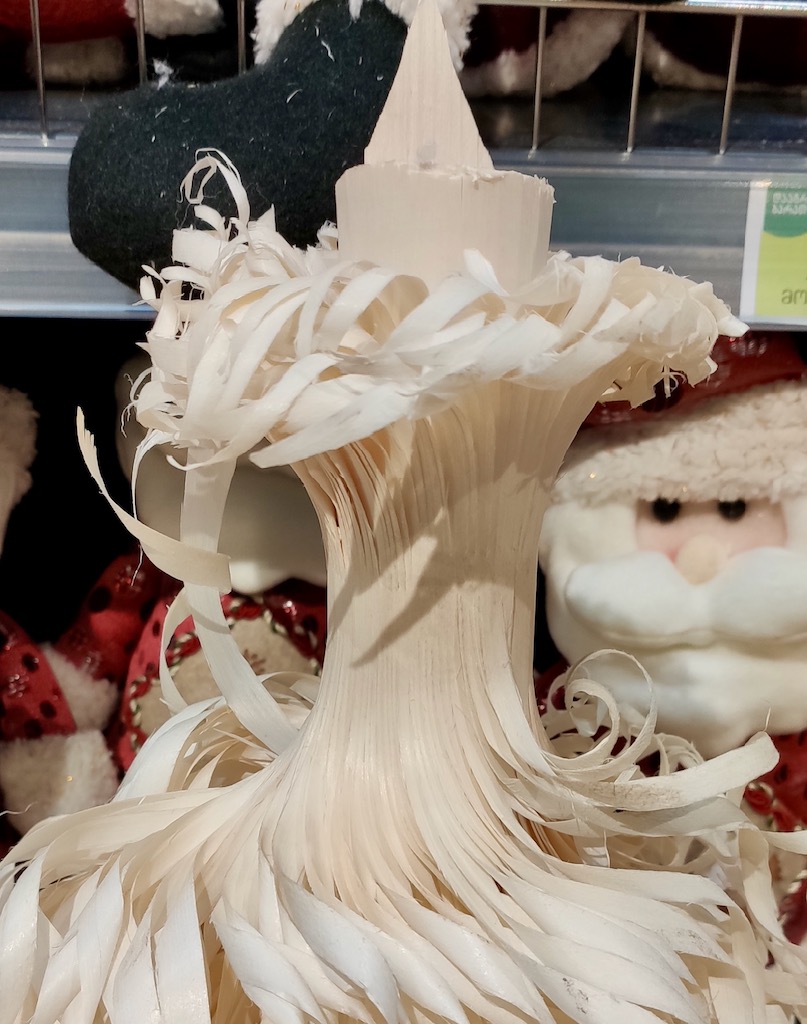

“Chichilaki,” its name, is made from a straight branch of hazelnut or walnut tree. Once dry, the craftsman barks and trims it. Then, using a cutting tool and working from bottom to top, he detaches thin strips of wood from the branch, leaving them attached to the top. By rotating the piece of wood and after several successive passes, the slats naturally loop, giving the woodwork the shape of a fir tree. A wooden cross is usually attached to the top of the “chichilaki.” Then it is decorated with fruits, berries, and flowers.


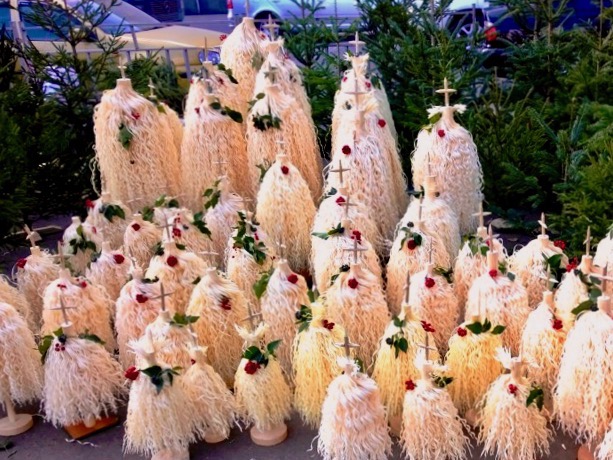

The chichilakis are burned ceremonially on January 19, the eve of the Georgian Orthodox Epiphany. This act symbolizes the previous year’s unrest going up in smoke.
Georgians consider chichilaki as a more environment-friendly Christmas decoration than actual pine trees.
And it’s Christmas Day, January 7
On Christmas Eve, candles are placed on the windowsill to be seen from the outside. But the real celebration will take place the next day.
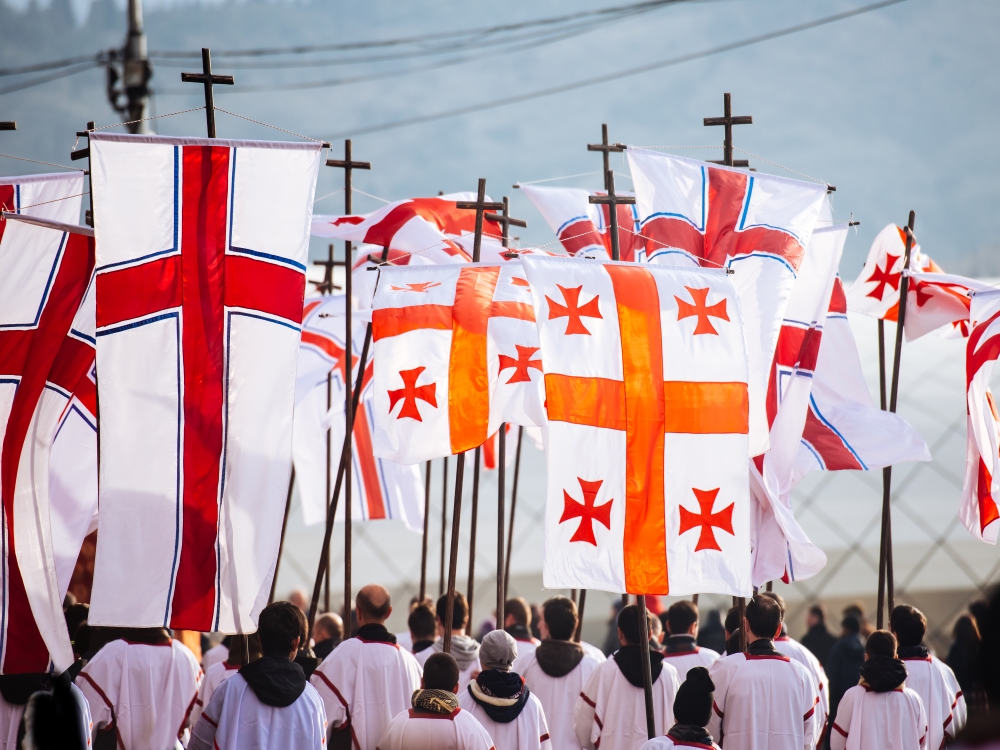

Christmas Day is also the day of the “Alilo,” a religious procession in which Orthodox Christians participate. Alilo comes from the name of a traditional Georgian Christmas carol. To celebrate, crosses, icons, and banners are carried through the streets to the sounds of Christmas carols.
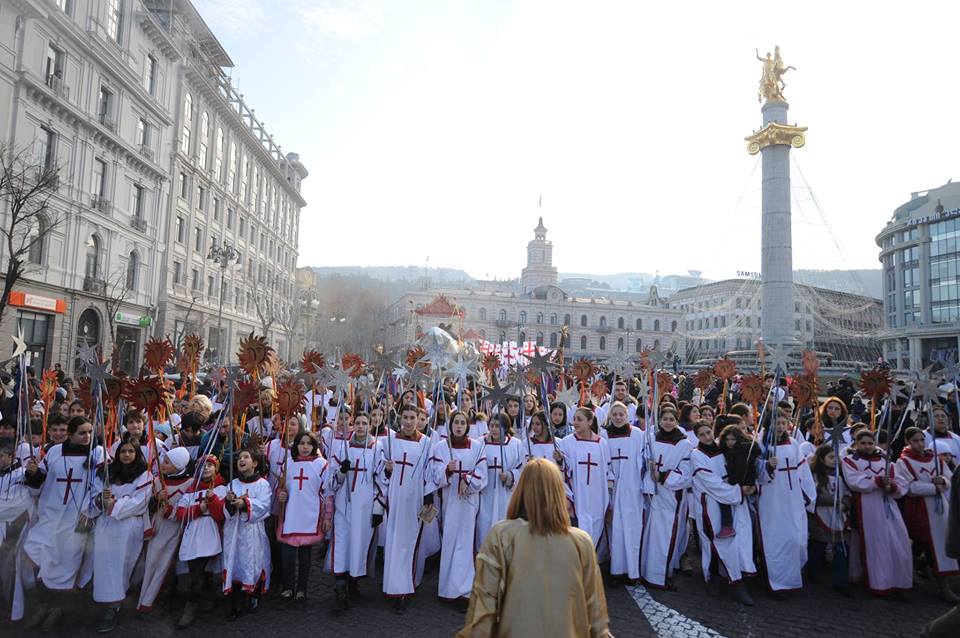

Alilo is a long-standing tradition that dates back to the 6th Century. People used to visit their families, wish them a merry Christmas by singing, and bring them presents. An egg symbolizing fertility is an unmissable gift. In return, they are given food and candies.
Today, the tradition is still alive but has evolved. The procession, led by children dressed in white, receives food, sweets, and gifts from the townspeople. These donations are collected in the church where the Christmas service takes place. After the service, they are distributed to those in need. The children who take part in the procession also have a little more personal purpose! They go from house to house and ask for treats, yelling the phrase “Trick or treat!“
The Christmas meal
Georgian cuisine is full of flavor. It is a mix of Mediterranean, Turkish, and Middle Eastern cuisines.
The main ingredients are nuts, pomegranate, red beans, cheese, honey, coriander, and garlic; all cooked with lots of butter and cream and accompanied by bread. It’s not light food, but it’s undeniably what makes it so tasty.
The two traditional Christmas dishes in Georgia are pork and turkey. For them, pork is a symbol of prosperity. For Christmas, piglets are grilled in Georgian style with herbs. The other dish, satzivi, is a dish made with turkey and walnut sauce.
After having a look at Georgian’s Christmas recipes, I selected some for a Christmas meal.
The “khachapuri”
This dish is a must try, eaten throughout the year, and I’ll never get tired of it. The translation would be “Georgian cheese bread” or “cheese pie.” It is one of the staple foods of the Georgian diet. Several versions exist, each specific to a different region.


Imeruli khachapuri: Round in shape, the cheese is inside the bread.


Megruli khachapuri: It is similar to the previous one, but it has added cheese and butter on top.


Acharuli khachapuri: It has a boat’s shape, filled with melted cheese and butter, and a raw egg is added to finish it off. It is served hot — whisk the cheese, egg, and butter with a fork before tearing the dough’s edges to plunge them into the mixture. My favorite! I have the recipe right here if you want to try it.
Ingredients (4 servings)
- 500g flour
- 400g mozzarella or feta
- 4 eggs
- 150 ml lukewarm milk
- 1 packet of baking yeast
- 3 tbsp olive oil
- 1 tbsp caster sugar
- 1 teaspoon salt
Direction
Total 30 min
Cooking 15 min
Rest 1 h 10 min
- Preheat the oven to 200 degrees C. Heat the milk in a saucepan. Mix the lukewarm milk, sugar, and yeast in a bowl. Leave to rest for 10 minutes. Gradually add flour, oil, and salt. Knead the mixture until you get an elastic paste without being sticky. Add water if necessary. Cover the bowl and let the dough rise in a warm place for 1 hour.
- Once the dough has rested, knead it again. Divide the dough into 4 balls. Pour flour on your worktop. Using a rolling pin, spread each dough ball in a circle about 5 mm thick. Fold the edges of each end to form an oval boat.
- Cut the cheese into small pieces. Place the shaped boats on a baking sheet lined with parchment paper. Top each with cheese and bake for 10 minutes.
- When they come out of the oven, break an egg on each khachapuri. Bake again for 5 minutes, monitoring the cooking. Make sure the egg yolk remains liquid. To be enjoyed immediately hot.
Salted satzivi, a turkey recipe with walnut sauce


Savory satsivi is a Georgian national meal of tender and boiled poultry, coated with a thick and creamy sauce with nuts and garlic. It is generally served cold, which allows the dish to be prepared the day before, but some also appreciate it hot.
Satsivi sauce
Ingredient (4 servings)
- 2 cloves garlic
- 1 shallot
- 200 g of shelled walnuts
- 3 coriander seeds
- 4 peppercorns
- 2 tablespoon (s) chopped chives
- 1 good pinch of saffron
- 1/4 teaspoon (s) of paprika
- 1 pinch of cinnamon
- salt
- 2 egg yolks
- 10 cl of cider vinegar
- Chicken stock
Direction
Total 20 min
Cook 5 min
- With a blender, chop the garlic, shallot, walnuts, herbs, and coriander
- Gradually add the vinegar, egg yolks, spices, then the boiling broth. Add enough broth to make a thick sour cream.
- Heat the sauce, possibly in a water bath because it should not boil
- Serve the sauce with boiled poultry
Mtsvadi, Georgian barbecue


“Mtsvadi” is called the dish of kings, and Georgians have enjoyed it since ancient times. It was a heritage from their ancestors when they feasted on meat cooked on the fire after the hunt. It is even said that King Heraclius II, one of the greatest kings of Georgia, particularly liked to eat “mtsvadi” in the mountains.
Mtsvadi can be made with pork, mutton, or veal. You can of course use beef if you prefer, but for Georgians, it will no longer be the traditional “mtsvadi.”
The peculiarity of the dish is that the meat is marinated in pomegranate juice before being roasted, making it incredibly tender, juicy, and delicious.
Ingredients (4 servings
- 1 kg of pork / mutton / veal
- 2-3 onions
- 300-400 ml of freshly squeezed natural pomegranate juice
- 1 tablespoon of oil
- Salt and pepper
- You can add dried spices (Khmeli suneli) or coriander seeds
Direction
Total 20 min
Cook 5 min
- Cut the meat into medium sized pieces and cut the onions into rings.
- Prepare the marinade with the pomegranate juice, dried spices, pepper, finely crushed coriander seeds and salt.
- Marinate the meat, making sure the meat is completely covered. Ideally, the meat should stay like this in the refrigerator for 2 days, but if you are in a hurry, one day is enough.
- Skewer the meat and roast it on the barbecue. This slow cooking method over a fire not only makes the meat tender, but it also adds great flavor. You can also cook it in a hot pan or on the grill in your oven.
Eggplant and Walnut Wraps


Ingredients (4 servings)
- 3 medium eggplants
- Grape seed oil
- 1 tablespoon of walnut oil
- 120 g of fresh walnuts
- 1 garlic cloves
- 1 teaspoon of ground coriander
- 1 teaspoon of turmeric
- 1 teaspoon of vinegar
- 60 ml of boiling water
- Half a bunch of fresh coriander (or fresh parsley)
- 1/2 pomegranate
- Salt
Direction
Total 30 mn
Cook 10 mn
Rest 30 mn
- Wash and cut the eggplants into thin slices of 5 mm. Sprinkle them with coarse salt and let them rest for 30 minutes.
- In a bowl of a food processor, place the nuts, garlic and spices. Add the walnut oil and mix everything. Pour in the vinegar and boiling water and mix again. Pour the nut paste into a bowl and add the chopped cilantro and pomegranate seeds (keep some seeds for decorating the plates). Book
- Wipe the eggplant slices. Heat the grape seed oil in a pan. Place the eggplant slices and cook for 4-5 minutes on each side. Place the eggplants on absorbent paper and let cool. Once cold, place the walnut paste on the eggplant slice and roll them to form a roll.
- Make a plate with the eggplant rolls. Sprinkle with fresh chopped cilantro and pomegranate seeds.
Spinach and pomegranate balls


Pkhali or fkhali is a dish of Georgian cuisine made from chopped vegetables, including cabbage, eggplants, beans, beets, or spinach, mixed with ground nuts, vinegar, onions, garlic, and cilantro.
As we already have a dish with eggplants on the list, I opted for spinach: “ispanakhis pkhali.”
Ingredient (4 servings)
- 700 g fresh spinach
- 220 g walnuts
- 1 bunch of chopped cilantro
- 4 garlic cloves, finely chopped
- 1 green onion, chopped
- 2 tablespoons of red wine vinegar
- 4 tablespoons of walnut oil
- 1 teaspoon of ground coriander
- 1 teaspoon of ground fenugreek
- Salt
- Pepper
- Pomegranate seeds
Direction
Total 20 mn
Cook 5 mn
- Blanch the spinach in a large volume of salted boiling water for 5 minutes to soften them.
- Drain them and immediately immerse them in a large volume of ice water to stop cooking and keep them green. Drain and squeeze to extract as much moisture as possible.
- Roughly chop the spinach.
- Grind the nuts to get a coarse powder.
- Mix the ground nuts with all the other ingredients to obtain a homogeneous mixture. Refrigerate for 6 hours before eating.
- Ispanakhis pkhali can be shaped into individual balls or served in a tray for the whole table.
- Garnish the ispanakhis pkhali with pomegranate seeds, coriander leaves and / or whole walnuts.
The dessert


Traditional Christmas desserts eaten in Georgia include “gozinaki,” honey nut candies, and churchkhela, a nut treat.
A symbolic “tabla“, a small tray with sweets, is served at the end of the Christmas meal.
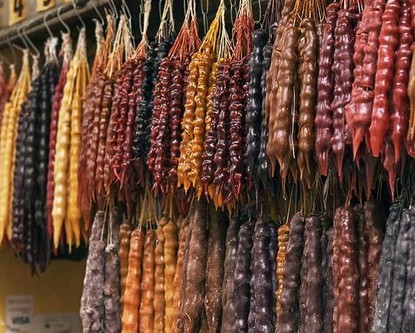



Churchkhela is Georgia’s most popular treat. It’s a string of nuts dipped in a syrup made from grape juice and left to dry. The syrup dries into a chewy jelly surrounding the nuts.
For my dessert, I will serve our traditional French Christmas dessert, the Bûche de Noël. Because a Christmas without a Christmas log is not quite Christmas!
Conclusion
I hope you will appreciate this Georgian menu the same way I did. Georgian cuisine is so savory and generous!
For an alternative, I served the Satzivi sauce with fish and tofu as well. It is a great choice for everyone to enjoy.
Bon appétit!
I wish you all a Merry Christmas, and a wonderful holiday season.
